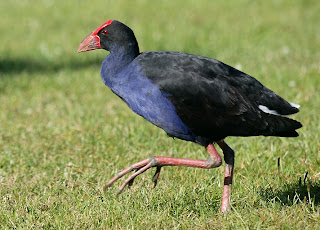 |
| Pukeko bird |
Dubai Airport terminal is massive and though "award-winning" is most unpleasant in my view. There are pathetically few lavatories which are greatly oversubscribed and constant teams of attendants from poorer Asian countries are required to maintain them. The airport is supposed to be home to some of the best duty free shopping in the world but my investigations prove that electrical goods, watches and jewellery can be bought more cheaply in British high streets. At the airport, you see all creeds and nationalities as travellers from every continent pass through this vital "hub". We boarded a huge five hundred seater A380 airbus bound for Manchester and were delighted to discover that it was only half full - meaning we could spread out and feel less like New Zealand sheep crammed on to a truck.
Speaking of New Zealand, I think that one of the things we will always remember is the birds that live there - from kiwis to pied stilts and from tuis to unfamiliar hawks pecking away at roadkill - usually brush tailed possums. We would sometimes wake to tuneful birdsong we had never heard before and at Rotorua, as we observed a bubbling vent, a pukeko bird strutted out of the undergrowth. Of course we saw keas on the South Island and a recently deceased yellow hammer by an electric fence. Victorian immigrants - mostly from England - not only brought sheep, cows, cats and dogs with them but also house sparrows, thrushes, blackbirds - presumably to make them feel more at home.
New Zealand was once a land of birds. There were virtually no mammals - just a few bats and seals. That's why flightless birds evolved in the forests - they had no predators until the Maori people arrived. They obliterated the moas and several other species long before Captain Cook's cabin boy, Young Nick, first spotted the headland near Gisborne that was later named after him.
Human beings have done their best to wreck the living aviary that was New Zealand. The destruction goes on. Keith Woodley at the Miranda Shorebird Centre has seen a steady decline in shorebird numbers during his nineteen years in charge there. Meanwhile the government has endorsed a widespread poisoning campaign to reduce brush-tailed possum numbers on the South Island but precious and unique birds like the weka are also tasting the possums' poison - and dying. I dedicate this post to the native birds of New Zealand.
 |
| Variable oystercatchers at Whangarei Heads |
 |
| Weka at Cape Foulwind |
 |
| Giant moa in Auckland Museum |



Thank you, on behalf of huia, laughing owl, crested moa, Mantell's moa, upland moa, Finsch's duck, little bush moa, adzebill, New Zealand coot, brown goshawk, Souther merganser, New Zealand musk duck, heavy-footed moa, North and South Island giant moas, North and South Island snipe, New Zealand bittern, grey-headed blackbird, Hawkin's rail, South Island piopio, megapode, snipe rail, South Island kokako, Hutton's rail, bush wren, Forbe's eagle, Hodgen's waterhen, Dieffenbach's rail, moho, Haast's eagle, Forbe's harrier, Lyall's wren, owlet nightjar, South Island snipe, North and South Island goose, stout-legged wren, Scarlett's duck, and all...
ReplyDeleteApparently the bush dawn chorus used to be 'deafening'.
Welcome back.....how lovely all the birdsong must have been...I would love to visit NZ...maybe one day.
ReplyDeleteKATHERINE How wonderful it would have been to be the first human being to wander through a New Zealand forest. In terms of the world's ecological history - it was - frustratingly - just yesterday.
ReplyDeleteLIBBY If you win the national lottery I will be happy to carry your bags and be your personal driver whilst in New Zealand. I shall also be happy to sample your T-bone steaks and sauvignon blanc.
nice to have you back in blighty....... as for NO country for old men
ReplyDeleteloved the movie!
Glad you enjoyed your holiday.
ReplyDeletecheers
Welcome back, YP. You seem to have had a truly wonderful holiday and I'm sure the memories will stay with you for a long time to come.
ReplyDeleteI love the birds, it always amazes me how many shapes and sizes they can be found. Imagine how diverse people would be if that were so with humans.
ReplyDelete